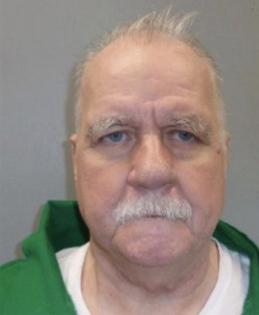In first for state, South Carolina death row inmate elects to die by firing squad
Published in News & Features
COLUMBIA, S.C. — A South Carolina man on death row has opted to die by firing squad. Brad Sigmon, who was sentenced to death for beating his ex-girlfriend’s parents to death with a baseball bat, is the first person in South Carolina to select this method of execution since it was added as an option in 2024.
He is scheduled to be executed on March 7.
At 65, Sigmon would be the oldest person ever put to death in South Carolina and the first person executed by a firing squad.
Death row inmates in South Carolina are given the choice of their method of execution between lethal injection, electric chair and the firing squad. Since executions in the state resumed in September 2024, all three men executed have selected lethal injection.
The South Carolina General Assembly added the firing squad as an option in 2021. Its addition came after the state had to pause executions for nearly a decade when it ran out of the drugs needed to perform the lethal injection.
Following legal challenges, the General Assembly also reinstated the use of the electric chair as well altered the lethal injection protocol to a single dose of pentobarbital instead of the previous three-drug cocktail. If an inmate makes no choice, the default is the electric chair.
Sigmon’s choice of the firing squad comes as concerns have grown about the use of pentobarbital, a powerful sedative that causes asphyxiation at high doses. The federal government, which also uses pentobarbital, is currently reviewing the drug over concerns that it causes an unnecessarily painful death.
Legal filings have raised the concern that the drug, which is as caustic as household cleaners and ammonia, causes a pulmonary edema, where the lungs fill with fluid, causing the person to feel as if they are drowning.
“The choice Brad faced today was impossible. Unless he elected lethal injection or the firing squad, he would die in South Carolina’s ancient electric chair, which would burn and cook him alive. But the alternative is just as monstrous,” said Gerald “Bo” King, a Federal Public Defender and one of Sigmon’s attorneys.
Partial autopsy records as well as witness testimony from inside of the state death chamber at the Broad River Correctional Institution in Columbia, suggest that two executed inmates, Richard Moore and Marion Bowman Jr., received double the dose of pentobarbital than prescribed by the federal Bureau of Prisons’ protocol. Representatives of the South Carolina Department of Corrections have said their protocol mirrors the federal protocol.
However, little information can be disclosed about the lethal injection process due to a nearly impenetrable shield law passed by the South Carolina General Assembly. The law makes it illegal to disclose most information about the lethal injection process, including how the drugs are sourced and stored.
As a result, attorneys for many of the men on death row have argued that they are unable to determine whether the drugs are expired or improperly stored. This would increase the likelihood of a painful or even botched execution, according to the attorneys.
“If I had to choose how to be killed, I’d probably pick being shot too, as long as I trusted the shooter to get it right,” said Abraham Bonowitz, executive director of Death Penalty Action, in a statement. “Brad Sigmon’s case exposes significant problems with the treatment of people who have experienced childhood trauma and undiagnosed, inherited mental illness.”
Sigmon would also only be the fourth person to be executed by firing squad in the United States in the last 65 years.
“I saw what the bullets did to my brother. I was there when it happened and I have the autopsy photos,” said Randy Gardner, the brother of Ronnie Lee Gardner, who was executed by firing squad in Utah in 2010. “The death penalty only creates more victims. There is no humane way to execute anyone,” Gardner said in a statement.
Who is Brad Sigmon?
On April 27, 2001, following a night of drinking and smoking crack cocaine, Sigmon broke into the home of the Larke family in Greenville, South Carolina. His plan was to tie up the parents, David and Gladys, so that he could spirit away their daughter, Becky, who had recently broken up with him after a three-year relationship.
Sigmon believed, according to his lawyers, that if he could just get some time alone with Becky, he could convince her to take him back.
But when David Larke fought back, grabbing a gun, Sigmon beat him to death with a baseball bat. He then murdered Gladys Larke in the same manner, reportedly going back and forth between different rooms to finish them off. Sigmon then forced Becky into his car and drove off, later saying that he intended to commit suicide.
When Becky fled the car on foot, Sigmon shot at her several times but missed.
The night of the killings, Sigmon was suffering intense delusions as a result of his “fractured mental state,” according to his attorneys. Sigmon grew up in an unstable and violent home — while his mother was regularly absent, his father was an alcoholic who physically abused Sigmon’s mother and four younger siblings. From a young age, Sigmon, the eldest child, was regularly hit and punched while attempting to stand up to his father.
Mental illness is “rampant and severe” in Sigmon’s family and among his siblings, according to his attorneys. Many have been diagnosed with bipolar disorder, schizophrenia, depression and suicidality, according to court filings.
Made homeless as a teenager, Sigmon turned to drugs and alcohol and developed severe, untreated bipolar disorder, according to court filings.
Doctors diagnosed him with an underlying, organic brain injury that left him more susceptible to intoxication and less able to understand the consequences of his actions.
Sigmon’s attorneys have argued that his the lawyers at his original trial failed to properly present his mental illness as a mitigating factor. The original attorneys had no experience with death penalty trials, according to a habeas corpus petition asking the South Carolina Supreme Court to stay his execution.
The failure to address Sigmon’s mental health extended into the courtroom, his attorneys say.
While awaiting trial, Sigmon was diagnosed with depression but his bipolar disorder was left untreated. As a result, during the sentencing phase at trial, Sigmon made his own closing argument to jurors before they sentenced him to death.
In a frantic and pleading speech, he showed off a suitcase he had packed the night of the murders containing lingerie and bath oil, waved Polaroid pictures of Becky only wearing a bra, proclaimed that he was guilty and told the jury that their breakup had “set me off.”
_____
©2025 The State. Visit at thestate.com. Distributed by Tribune Content Agency, LLC.







Comments